|
Nostalgia demo 1
Nostalgia demo 2


|
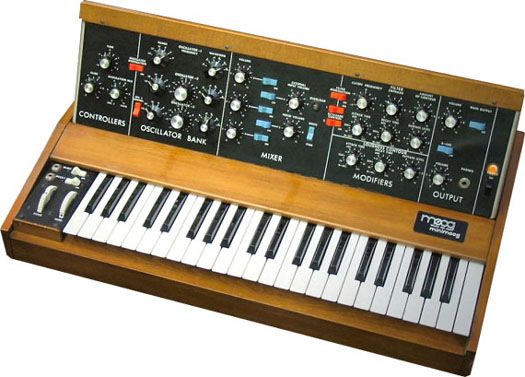
|
The MiniMoog is quite possibly the most
important synthesiser ever made!
Before the MiniMoog, there were only modular synths... vast, sprawling
things that cost tens of thousands of dollars, took up an entire
room, were difficult to understand (and operate) and required metres
of spaghetti-like patch cords just to get a sound out of the things.
But this all changed with the MiniMoog.
Compact and portable and relatively affordable, it did not require
patch cords and sounds could be created quickly and easily even
by people unfamiliar with synthesisers.
After the enormous success of Walter Carlos's 'Switched On Bach'
albums, everybody wanted a Moog synthesiser (even the Rolling Stones
bought one!!) but Dr Bob Moog was aware of the fact that his huge
modulars were intimidating (and expensive) and sought ways to make
this exciting new technology more accessible.
Through close association with the early pioneers such as Carlos,
it was determined that the principle building blocks for almost
every sound were an oscillator (or two) into a filter into
an amplifier with pitch controlled from a keyboard and the filter
and amplifier controlled (or articulated) by an envelope generator.
Armed with this knowledge, Moog sat down to design a simplified
synthesiser that did not require patchcords but could still offer
a lot of tonal flexibility. The result, of course, was the MiniMoog...
the world's first pre-patched synthesiser.
There were several versions of the MiniMoog that never saw the
light of day. There was the Model A, something not unlike a mini-modular
to look at. Then came the Model B with a sloping panel. Then there
was the Model C which was closer to the design we know today and
finally, the Model D (shown above) which sported Moog's unique pitchbend
and mod wheels.
 |
 |
 |
| MiniMoog Model A |
MiniMoog Model B |
MiniMoog Model C |
Today, the design (whilst classic) is now taken for granted and
it is for this reason alone that the MiniMoog is the most important
synthesiser design ever - the voice architecture defined in the
MiniMoog has formed the basis of almost every other synth since
and has been adopted (and adapted) by almost every manufacturer
in one way or another. From humble monosyths through to the mighty
Yamaha CS80, the Prophet 5 and every subsequent analogue polysynth...
the PPG/Waldorf too. The Roland D50... the Korg M1... the Prophet
VS and Korg Wavestation... the modern Yamaha Motifs, the Korg Tritons
and Karma, the Roland Fantom.... with the exception of the Yamaha
FM synths, you name a synth and you can bet that its voice architecture
is pretty much based in one way or another on the one defined by
the MiniMoog back in 1970! Even the Kompakt player that will host
these samples owes much to the synth they were taken from. The technology
involved might be different but the influence of the MiniMoog is
literally everywhere.
But what else made the MiniMoog such a special synth? On paper,
it wasn't actually that well specified! Heresy perhaps but it's
a fact! |
| The MiniMoog had an impressive complement
of three audio oscillators but, in the absence of a dedicated LFO,
Oscillator 3 was invariably switched to its LOW FREQUENCY setting
and tied up as an LFO for vibrato and filter sweeps, etc., so essentially,
the MiniMoog really only had two audio oscillators most of the time.
That said, many did use the three oscillators and many others had
their MiniMoogs modified to add a simple LFO.
There was a 5-channel mixer that allowed you to balance the levels
of the three oscillators and also a white/pink noise source and
an external audio input. |
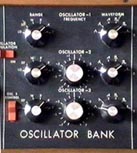 |
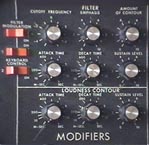 |
The output of the mixer passed to a 24dB/Octave
lowpass filter and then an amplifier and these were controlled by
a somewhat unusual ADS envelope (there was no dedicated RELEASE
control... release time was set by the DECAY control and was only
active when the DECAY switch to the left of the keyboard was enabled).
But the MiniMoog had no pulse width modulation, no oscillator
sync, no ring modulator, no sample and hold, no elaborate modulation
matrix ... in fact, it was missing many of the functions and features
that we take so much for granted now |
| So why was it a success?
At first, of course, it was because there was nothing else like
it available. However, even after the Odyssey was released and was
followed by other monosynths from other companies (and, indeed,
from Moog themselves), the MiniMoog continued to dominate the market.
What's even more peculiar is that in its eleven year life, the MiniMoog
didn't change.... at all. There were changes to the internal circuitry
to improve stability but there was never a MiniMoog II or anything
like that and all those 'missing features' were never added. When,
in 1981, the very last one rolled off the production line (serial
#13259 which was ceremoniously given to Bob Moog in recognition
of his achievement), it still lacked all the features expected
of a synth of the era. I guess the attitude must have been "if
it ain't broke, don't fix it"!
So what was the secret of its enduring success
and appeal?
The user interface to begin with. There is just something
about that hinged panel that just screams "tweak me" and
the size of the knobs and the space between them makes this possible
for even the pudgiest of fingers. The large rocker switches (colour
coded - blue for audio, red for control voltage) were also reassuringly
comfortable to use. The left-to-right 'flowchart' of the panel also
made it easy to understand and even novices could get something
out of the MiniMoog. Also, the construction was sturdy and robust
and the quality of the woodwork was such that you felt you were
playing an instrument, not a box of electronics and although
cosmetics have absolutely no effect on sound quality, the MiniMoog's
classic good looks were (and remain) important aspects of the MiniMoog's
desirability. The keyboard too, whilst synth action and not velocity
sensitive, was very playable. And those wheels - they were difficult
to master at first but they gave the MiniMoog a truly expressive
voice and in the hands of a MiniMoog virtuoso such as Jan Hammer,
the thing could really sing.
But more than anything, it was the sound of
the thing that defined the MiniMoog. Some may disagree but nothing
sounds quite like a MiniMoog (other than, perhaps, a Moog modular).
It has a full, rich character that was unique during its lifetime
and remains unique today. Each oscillator on the MiniMoog was like
some living being and a waveform from one won't sound quite like
the same waveform on another. The fact that they didn't track particularly
accurately was also a contributing factor to the almost 'organic'
sound of the MiniMoog. The way the oscillators interacted when detuned
and mixed also introduced certain pleasant non-linear artefacts
and pushing the mixer levels to maximum also caused soft clipping
which added further to the character of certain sounds. Then there
was 'that filter'.... the famous Moog 'ladder' filter... technically
flawed and imperfect but who cares... it just sounded fabulous!
The envelopes were also fast and punchy and their attack, decay
and release slopes were just... well... so 'natural', almost acoustic
sounding. But it was the sum of its parts, the combination of all
these factors that led to the legendary sound of the MiniMoog.
When the MiniMoog finally ceased production in 1981,
there was a void in the market waiting to be filled. |
American company, Studio
Electronics, had built their business taking
original MiniMoogs and cannibalising them into a rack-mount case
and these were very popular with many pro musicians. They also added
a dedicated LFO, oscillator sync and other features such MIDI, velocity
sensitivity, new triggering options and more. Initially, they did
this to order, taking in customer's own MiniMoogs and rack mounting
them. Then they started buying in MiniMoogs to create the MIDIMoog
which was sold as a product in its own right.
When the supply of Minimoogs started to become scarce, SE started
building their own circuit boards. These were an exact clone of
the original's and were hand built with all of the original components. |
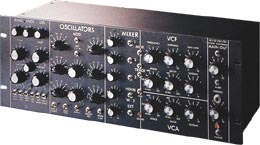 |
With the new circuit board designs, SE
couldn't use the Moog name for copyright reasons and so changed
it to 'MidiMini'. They sounded great and if there were any sonic
differences between SE's new circuits and the original MiniMoog,
they were too insignificant to notice. The only thing that dogged
the MidiMini was its price - at around $3,000, it was only die-hard
MiniMoog fans who bought them. Even now, a used MidiMini will fetch
$2,500 or more!
Studio Electronics went on to make the SE1,
a programmable version of the unit with added LFOs, envelopes, etc..
Opinion is divided about the sound of the SE1 though - some claim
the it is a perfect reproduction of the original whilst others claim
it isn't.
But the story of MiniMoog cloning doesn't end there. |
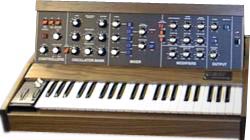 |
In 1998, a company from South Wales in
the UK (of all places!) rather unexpectedly brought out an almost
100% perfect clone of the original MiniMoog (left) complete with
walnut casework - even the knobs were the same as those used on
the original (they couldn't source the original rocker switches
though).
This company had (somehow) acquired the Moog name and traded under
the name Moog Music UK - the Moog MiniMoog was reborn!
This new MiniMoog also added MIDI and PWM but herein lies a puzzle..... |
Moog Music UK were apparently intent on
preserving the original as closely as possible and so deliberately
left off things like oscillator sync, a dedicated LFO, a velocity
sensitive keyboard, sprung pitchbend wheel and so on in order to
remain true to the original design. From a purist's point of view,
these were noble intentions I am sure but they had already deviated
from the orginal's specs by adding MIDI and PWM.... why not, then,
add these other refinements rather than shackle users with the 'failings'
of the original? Hmmmm! A missed opportunity.
Moog Music UK had ambitious plans to produce modular
synths, a rack version of the MiniMoog, a polyphonic MiniMoog with
memories and more. However, in 1998, the asking price of £1,500
for their new MiniMoog was just too much for most people to justify
on a non-programmable monosynth especially when the same amount
could buy a complete synth workstation. In fact, for less money,
you could lay your hands on a genuine MiniMoog with a MIDI
retrofit and given that this new Welsh MiniMoog offered nothing
intrinsically new over the original, this seemed a more attractive
option. Ok... for £1,500, Moog Music UK offered a brand new
unit and a year's warranty and so on but for £1,000 (or less
at the time) you get yourself 'the genuine article'.
With very few or no sales, this little company from Caerphilly,
South Wales, floundered and the company folded not long afterwards. |
Of course, the legend now lives on in the form of Robert
Moog's own MiniMoog Voyager (right). Most if not all of the MiniMoog's
endearing qualities remain but have been augmented and enhanced
with new and innovative features not least of which are memories
to store sounds.
It retains three oscillators but also has a dedicated LFO as well
as oscillator sync, 'proper' ADSR envelopes and a simple but very
versatile modulation matrix. It also has a totally variable (i.e.
not switched) waveform selector control for each of the three oscillators
and this can be modulated for some very interesting tonal movement. |
 |
It also has dual filters to expand the
synth's tonal capabilities beyond that of the original. At the centre
of the panel is a unique, touch sensitive XY controller pad for
some interesting performance possibilities.
However, once again, the jury is out about how it sounds. There
are claims that it sounds nothing like a MiniMoog but esteemed reviewers
have put the Voyager through its paces side-by-side with an original
Mini and whilst the sound might be slightly 'different' in some
respects, it would appear that it still retains the essential MiniMoog
personality and character. It's not cheap, however, but I guess
you have to pay for quality!
Nostalgia contains some choice multi-samples from an original MiniMoog
and also a Moog Voyager and even though these sampled 'snapshots'
cannot compare with the real thing, they are highly representative
of these classic instruments' essential sound quality.
FOOTNOTE...
Sadly, the genius who created the MinMoog left us recently when
he passed away on August 21st, 2005 but he leaves us with a heritage
that will live forever - Dr Robert Moog changed not only the way
music is made but the very music we make and he has inspired millions
of people across the world whether they be players or just lovers
of electronic or synth-based music.
Sleep gently Bob - your work will live on forever! |
|

